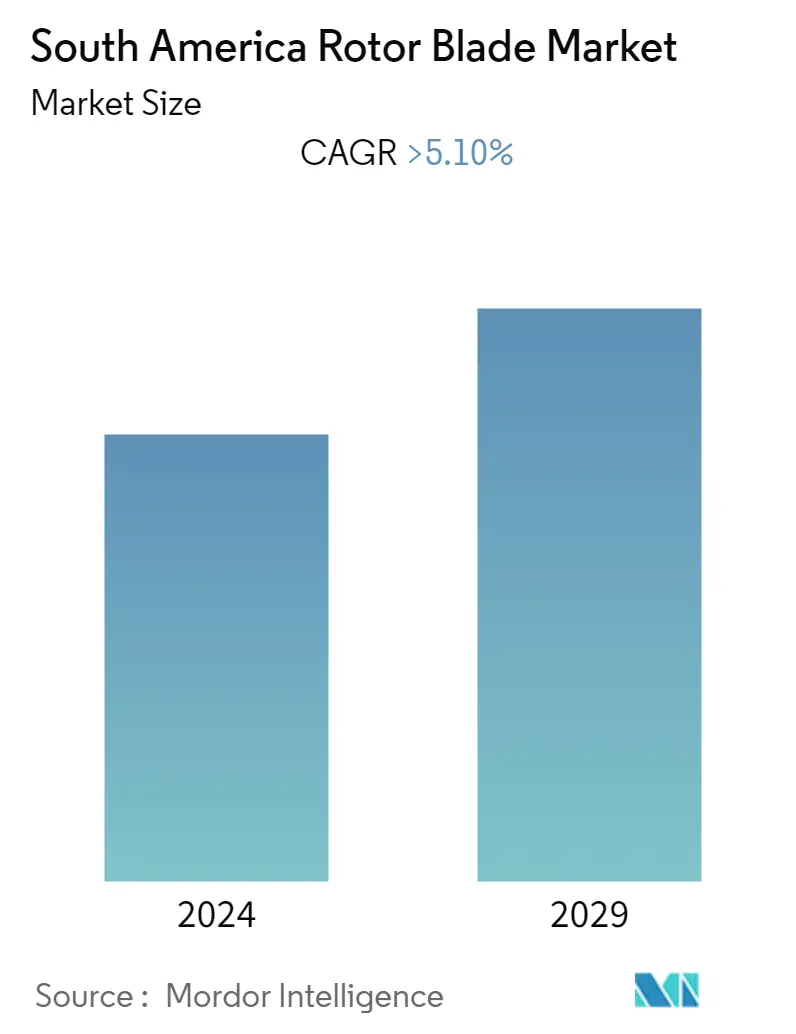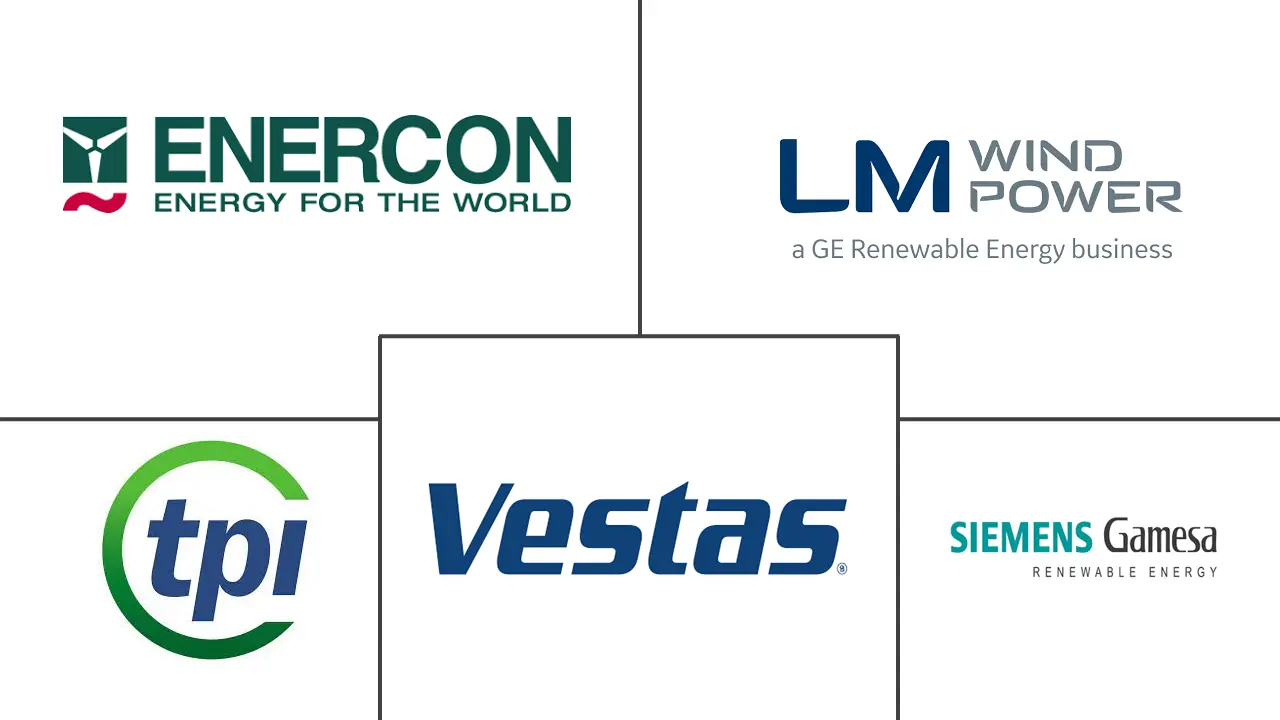Market Size of South America Rotor Blade Industry

| Study Period | 2020 - 2029 |
| Base Year For Estimation | 2023 |
| Forecast Data Period | 2024 - 2029 |
| Historical Data Period | 2020 - 2022 |
| CAGR | > 5.10 % |
| Market Concentration | Medium |
Major Players
*Disclaimer: Major Players sorted in no particular order |
South America Rotor Blade Market Analysis
The South American rotor blade market is expected to register at a CAGR of about 5.1% during the forecast period.
The market was moderately impacted by COVID-19 in 2020. It has now reached pre-pandemic levels.
- Over the long term, the major driving factors of the market are expected to be the growing number of offshore and onshore wind energy installations across the region.
- On the flip side, the associated high cost of transportation and cost competitiveness of alternate clean power sources, like solar power, hydropower, etc., have the potential to hinder market growth.
- The wind power industry has been in demand for cost-effective solutions, and a highly efficient product can change the industry's dynamics. There were instances where old turbines were replaced, not because of the damage but due to the availability of more efficient blades in the market. Hence, technological developments are opportunities for the South American rotor blade market.
- Brazil is expected to dominate the rotor blade market, with growing wind power installations across the country.
South America Rotor Blade Industry Segmentation
Rotor blades are the critical components of wind turbines, as they are in direct contact with high-speed winds. Rotor blades convert the wind's kinetic energy into rotational energy, which is later converted into electrical energy.
The South American rotor blade market is segmented by location of deployment, blade material, and geography. By location of deployment, the market is segmented into onshore and offshore. Blade material is segmented by carbon fiber, glass fiber, and other blade materials. The report also covers the market size and forecasts across major regions. For each segment, the market sizing and forecasts are calculated based on revenue (in USD million).
| By Location of Deployment | |
| Onshore | |
| Offshore |
| By Blade Material | |
| Carbon Fiber | |
| Glass Fiber | |
| Other Blade Materials |
| By Geography | |
| Brazil | |
| Argentina | |
| Colombia | |
| Peru | |
| Chile | |
| Rest of South America |
South America Rotor Blade Market Size Summary
The South American rotor blade market is poised for growth, driven by the increasing installation of offshore and onshore wind energy projects across the region. Despite the initial impact of the COVID-19 pandemic, the market has rebounded to pre-pandemic levels. The demand for cost-effective and efficient wind power solutions is a significant factor propelling the market forward. Technological advancements in rotor blade design and efficiency are creating opportunities for market expansion, particularly in Brazil, which is expected to lead the market due to its substantial wind power installations. However, challenges such as high transportation costs and the competitive pricing of alternative clean energy sources like solar and hydropower could potentially impede market growth.
Brazil's wind energy sector is rapidly expanding, with significant investments in onshore wind projects expected to drive the rotor blade market. The country's wind power capacity has surpassed notable milestones, and ongoing projects are set to further enhance its position in the global wind energy landscape. Chile also contributes to the regional market with its growing onshore wind capacity and ambitious renewable energy plans. The market is characterized by its fragmented nature, with key players such as TPI Composites SA, LM Wind Power, Siemens Gamesa Renewable Energy SA, Vestas Wind Systems A/S, and Enercon GmbH actively participating. Additionally, international collaborations and investments, such as those by Vestas and Sinoma Science and Technology, are expected to bolster the market's growth trajectory in the coming years.
South America Rotor Blade Market Size - Table of Contents
-
1. MARKET OVERVIEW
-
1.1 Introduction
-
1.2 Market Size and Demand Forecast in USD billion, till 2027
-
1.3 Wind Turbine Rotor Blades Price Analysis
-
1.4 Recent Trends and Developments
-
1.5 Government Policies and Regulations
-
1.6 Market Dynamics
-
1.6.1 Market Drivers
-
1.6.2 Market Restraints
-
-
1.7 Supply Chain Analysis
-
1.8 Industry Attractiveness - Porter's Five Forces Analysis
-
1.8.1 Bargaining Power of Suppliers
-
1.8.2 Bargaining Power of Consumers
-
1.8.3 Threat of New Entrants
-
1.8.4 Threat of Substitutes Products and Services
-
1.8.5 Intensity of Competitive Rivalry
-
-
-
2. MARKET SEGMENTATION
-
2.1 By Location of Deployment
-
2.1.1 Onshore
-
2.1.2 Offshore
-
-
2.2 By Blade Material
-
2.2.1 Carbon Fiber
-
2.2.2 Glass Fiber
-
2.2.3 Other Blade Materials
-
-
2.3 By Geography
-
2.3.1 Brazil
-
2.3.2 Argentina
-
2.3.3 Colombia
-
2.3.4 Peru
-
2.3.5 Chile
-
2.3.6 Rest of South America
-
-
South America Rotor Blade Market Size FAQs
What is the current South America Rotor Blade Market size?
The South America Rotor Blade Market is projected to register a CAGR of greater than 5.10% during the forecast period (2024-2029)
Who are the key players in South America Rotor Blade Market?
TPI Composites SA, LM Wind Power (a GE Renewable Energy business), Siemens Gamesa Renewable Energy, S.A., Vestas Wind Systems A/S and Enercon GmbH are the major companies operating in the South America Rotor Blade Market.

